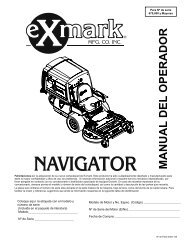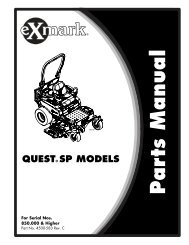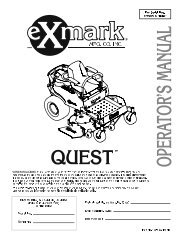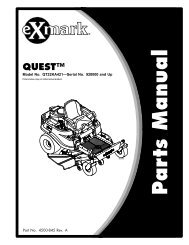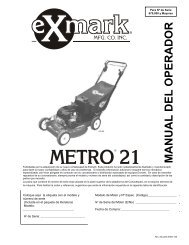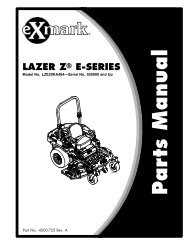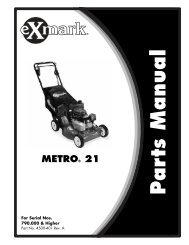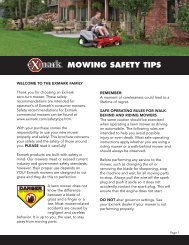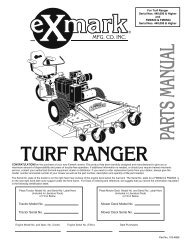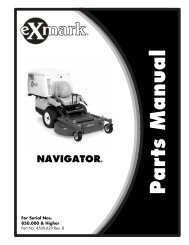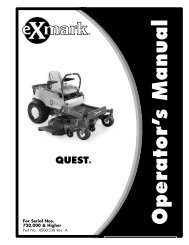Zero-turn riding mower safety tips - exmark lawn
Zero-turn riding mower safety tips - exmark lawn
Zero-turn riding mower safety tips - exmark lawn
You also want an ePaper? Increase the reach of your titles
YUMPU automatically turns print PDFs into web optimized ePapers that Google loves.
<strong>Zero</strong>-Turn Riding Mower Safety Tips<br />
Provided by Exmark Manufacturing Co., Inc.<br />
<strong>Zero</strong>-<strong>turn</strong>ing radius <strong>mower</strong>s offer efficiency, maneuverability and productivity. In short, they<br />
help get the job done in a lot less time. However, these machines, like all <strong>lawn</strong> <strong>mower</strong>s,<br />
require careful operation to prevent accidents when mowing around water, drop-offs, retaining<br />
walls, culverts, steep inclines and in wet environments. Any of these conditions can cause a<br />
loss of <strong>mower</strong> control, increasing the risk of a rollover or other accident.<br />
To promote safe operation, a rollover protection system (ROPS), now comes standard on all<br />
new professional zero-<strong>turn</strong> models. ROPS, in the fully raised position, can prevent an operator<br />
from being pinned under their machine. Without ROPS, the operator compartment or <strong>safety</strong><br />
zone – and more importantly, the operator – remains unprotected from the weight of the<br />
machine, which can exceed 1,700 pounds on some models.<br />
In combination with seat belts, ROPS are shown to be highly effective in preventing<br />
serious injuries or deaths if the equipment over<strong>turn</strong>s. The ROPS bar must be in the fully<br />
raised position - an operator is not protected by a ROPS bar that is folded or partially raised.<br />
While this type of protection system is an important <strong>safety</strong> feature, it is not a substitute for<br />
driving safely and consciously choosing to avoid hazards. Use the following <strong>tips</strong> to avoid<br />
operating in high-risk situations:<br />
Safety Equipment and Maintenance<br />
Read the information in your operating manual carefully. Make sure <strong>safety</strong> equipment such as<br />
the deflector shield, ROPS and <strong>safety</strong> interlocks are functional and utilized. Never bypass or<br />
remove any <strong>safety</strong> equipment. Perform regular equipment inspections and replace all parts<br />
including tires, belts, blades and fuel system components with original equipment parts and<br />
accessories. Perform maintenance of your <strong>mower</strong> per the instructions in the operating manual.
Training<br />
To maximize <strong>safety</strong>, performance and proper operation of the machine, it is essential that all<br />
operators carefully read and fully understand the contents of the operating manual. Safe<br />
operation of zero-<strong>turn</strong> <strong>mower</strong>s is essential. Failure to comply with the operating instructions or<br />
receive proper training may result in injury.<br />
Keep Movements Deliberate and Steady<br />
<strong>Zero</strong>-<strong>turn</strong> <strong>mower</strong>s operate differently than traditional <strong>riding</strong> <strong>mower</strong>s. They’re responsive and<br />
can <strong>turn</strong> on a dime – that’s why they are so popular. In the interest of <strong>safety</strong>, keep your<br />
speed under control and operate the control levers with smooth, even pressure.<br />
Maneuvering Hills<br />
Depending on the surroundings, you may feel more comfortable mowing side to side or up and<br />
down a hill. In either case, hills can cause a loss of traction. Do not mow on slopes greater<br />
than 15 degrees. Keep movements deliberate and steady. Don’t make sudden changes in<br />
speed or direction. Avoid mowing slopes under wet conditions. When using a bagging<br />
attachment, remember the weight of the grass clippings affects the stability of the <strong>mower</strong>.<br />
Retaining Walls and Other Drop-offs<br />
When operating a zero-<strong>turn</strong> <strong>riding</strong> <strong>mower</strong>, it’s important to review the area to be mowed, and<br />
note all hazards before beginning. Allow plenty of safe clearance in the vicinity of dropoffs<br />
and on unstable ground surrounding ponds, drainage ditches and other bodies<br />
of water. Without proper clearance, a wheel could slip over an edge, or the ground may give<br />
way. A good guide is to allow a safe area of two <strong>mower</strong> widths. Hand trim this area with a<br />
walk-behind <strong>mower</strong> and/or string trimmer. It is tempting to get close to the edges to eliminate<br />
a little hand work, but don’t sacrifice <strong>safety</strong> in the interest of saving a little time or effort.<br />
Loading and Unloading<br />
The ramp you use to load and unload your <strong>mower</strong> is also a slope. Use a full-width ramp that is<br />
long enough so that the ground-to-ramp angle does not exceed 15 degrees. Utilize your ROPS<br />
and seat belt whenever possible. When on the ramp, avoid sudden changes in speed, and do<br />
not attempt to <strong>turn</strong>.<br />
ROPS and Safety<br />
Keep the roll bar in the fully raised and locked position, and use your seat belt when<br />
operating the <strong>mower</strong>. An operator is not protected by a ROPS bar that is not fully raised.<br />
Commercial operators whose <strong>mower</strong>s are not equipped with ROPS should ask their local<br />
equipment dealer to install one. Exmark dealers will install a two-post ROPS for free on any<br />
Lazer Z, Lazer Z HP, and Lazer Z CT models manufactured with Serial Numbers 440,000 and<br />
below. Installation can be arranged by calling 800.667.5296 (in U.S. and Canada). For<br />
additional zero-<strong>turn</strong> <strong>safety</strong> information or to view the complete line of Exmark <strong>lawn</strong><br />
maintenance products, please visit www.<strong>exmark</strong>.com.



